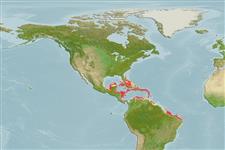Common names from other countries
>
Blenniiformes (Blennies) >
Chaenopsidae (Pike-, tube- and flagblennies)
Etymology: Lucayablennius: Composed from Lucaya = the old name for the Bahamas Islands + Greek, blennios = mucus (Ref. 45335).
Environment: milieu / climate zone / depth range / distribution range
Ecologia
marinhas associadas(os) a recifes; intervalo de profundidade 13 - 106 m (Ref. 9710). Tropical
Western Central Atlantic: Bahamas and Caribbean, including the Antilles.
Tamanho / Peso / Idade
Maturity: Lm ? range ? - ? cm
Max length : 5.0 cm SL macho/indeterminado; (Ref. 51458)
Descrição breve
Morfologia | Morfometria
Espinhos dorsais (total): 18 - 20; Raios dorsais moles (total): 19-20; Espinhos anais 2; Raios anais moles: 22 - 23. With emarginate caudal fin. Reddish tan, with 3 large dark spots along rear of dorsal fin base, and 2 similar spots along rear of anal fin base (Ref. 26938). Black stripe from tip of lower jaw through eye to end of operculum; a median dorsal light yellow line on head (Ref. 13442).
Inhabits coral reefs (Ref. 5521). Drifts with bended tail to prey on small fish. Retreats into holes or empty worm tubes. Ignores divers (Ref. 9710). Often seen with schools of masked gobies (Ref. 26938).
Life cycle and mating behavior
Maturidade | Reprodução | Desova | Ovos | Fecundidade | Larvas
Böhlke, J.E. and C.C.G. Chaplin, 1993. Fishes of the Bahamas and adjacent tropical waters. 2nd edition. University of Texas Press, Austin. (Ref. 5521)
Categoria na Lista Vermelha da IUCN (Ref. 130435)
CITES (Ref. 128078)
Not Evaluated
Ameaça para o homem
Harmless
Utilização humana
Mais informação
Nomes comunsSinónimosMetabolismoPredadoresEcotoxicologiaReproduçãoMaturidadeDesovaFecundidadeOvosDesenvolvimento dos ovos
Idade/TamanhoCrescimentoComprimento-pesoComprimento-comprimentoFrequência de comprimentoMorfometriaMorfologiaLarvasDinâmica larvarRecrutamentoAbundância
ReferênciasAquaculturaPerfil para aquaculturaEstirpesGenéticaElectrophoresesHereditariedadeDoençasProcessamentoMass conversion
ColaboradoresFotografiasStamps, Coins Misc.SonsCiguateraVelocidadeTipo de nataçãoÁrea branquialOutras referênciasCérebrosVisão
Ferramentas
Relatórios especiais
Descarregue XML
Fontes da internet
Estimates based on models
Preferred temperature (Ref.
115969): 23.5 - 27.6, mean 26.5 (based on 71 cells).
Phylogenetic diversity index (Ref.
82804): PD
50 = 1.0000 [Uniqueness, from 0.5 = low to 2.0 = high].
Bayesian length-weight: a=0.00457 (0.00183 - 0.01143), b=3.08 (2.86 - 3.30), in cm Total Length, based on LWR estimates for this (Sub)family-body shape (Ref.
93245).
Nível Trófico (Ref.
69278): 3.5 ±0.5 se; based on size and trophs of closest relatives
Fishing Vulnerability (Ref.
59153): Low vulnerability (10 of 100).
